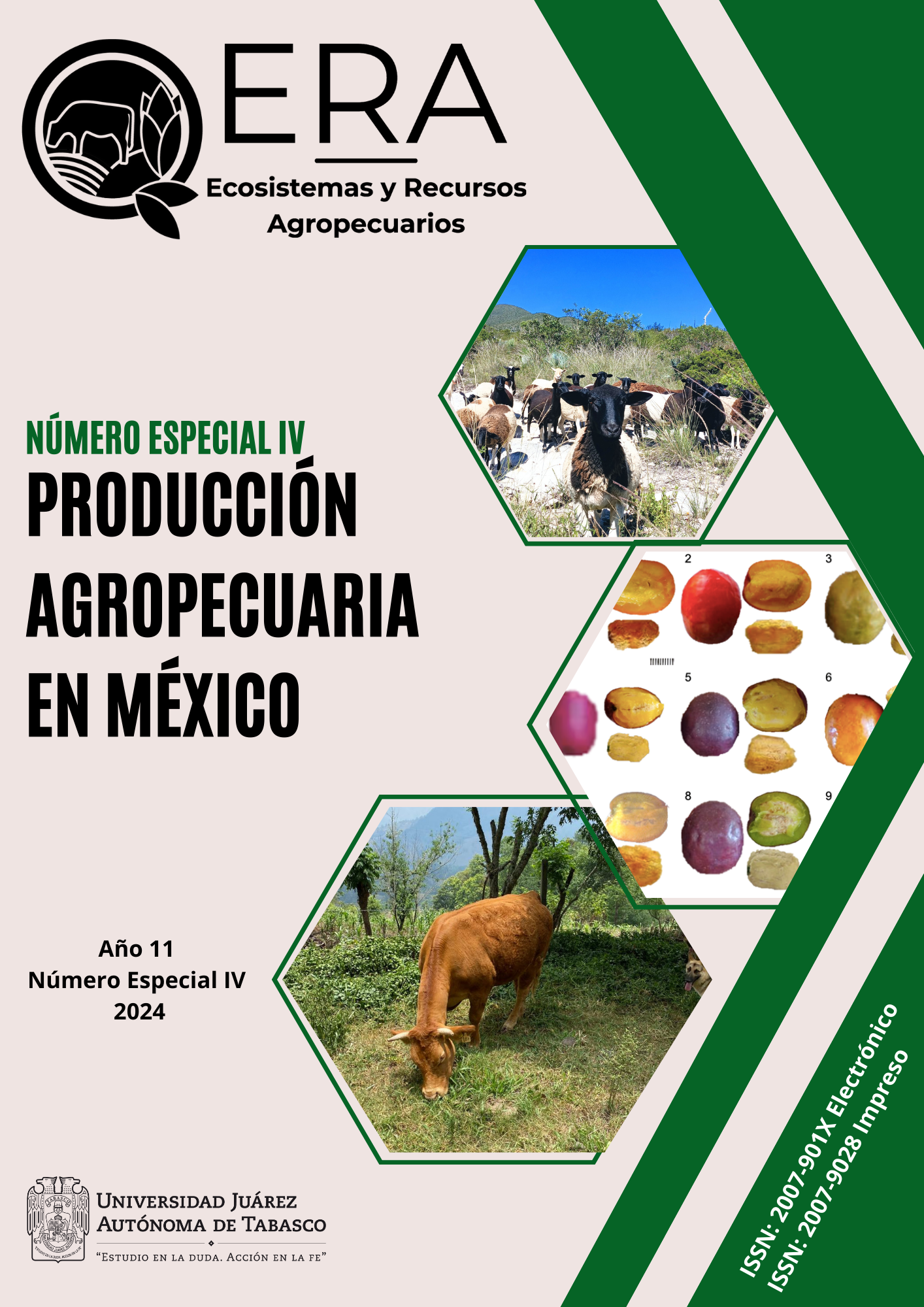Caracterización de raíces de portainjertos de cítricos desarrollados en contenedores
DOI:
https://doi.org/10.19136/era.a11nIV.4045Palabras clave:
Biomasa, calidad de planta, distribución espacial, sistema de raícesResumen
El objetivo fue evaluar las características de la raíz de portainjertos de cítricos, desarrollados en tubetes con diferentes sustratos. La siembra y desarrollo de las plantas se realizó en Cazones, Veracruz, México, y la evaluación en el Laboratorio de Fruticultura, Colegio de Postgraduados, Montecillo, Estado de México. Los portainjertos fueron naranjo agrio, Citrange C-35, lima rangpur y limón volkameriano, transplantados en tubetes de 1 L, llenados con arena, turba-agrolita (4:1 v/v) y tierra vega-tepojal (3:1 v/v). El diseño experimental fue factorial en arreglo de bloques completos al azar, con cuatro repeticiones de cinco unidades experimentales. Seis meses después del establecimiento se seleccionaron tres repeticiones de cuatro plantas por tratamiento, y se evaluó: altura de planta, diámetro de cuello, peso de materia fresca y seca de raíz, número de raíces por orden y longitud de raíces. Los datos se analizaron con el paquete estadístico SAS, se determinó un ANDEVA y comparación de medias de Tukey (p ≤ 0.05) La variable número de raíces se sometió a análisis de regresión polinomial. Tierra vega-tepojal dio calidad al desarrollo aéreo y radical, siendo una alternativa para el desarrollo de plantas en vivero, limón volkameriano mostró mayor longitud total de raíces, y en todos los portainjertos se encontraron raíces de segundo, tercero, cuarto y quinto orden. En el contenedor las raíces desarrollaron hasta la pared, luego se dirigieron a la base, donde hubo poda natural. El sustrato y contenedor influyeron en el desarrollo y forma de la raíz en los cuatro portainjertos
Descargas
Referencias
Allen KS, Harper RW, Bayer A, Brazee NJ (2017) A review of nursery production systems and their influence on urban tree survival. Urban For Urban Green 21: 183-191. https://doi.org/ 10.1016/J.UFUG.2016.12.002.
Barrera-Ramírez R, Vargas-Hernández JJ, López-Aguillón R, Muñoz-Flores HJ, Treviño-Garza EJ, Aguirre-Calderon OA (2021) Impac of external and internal factors on successful grafting of Pinus pseudostrobus var. oaxacana (Mirov) Harrison. Revista Chapingo Serie Ciencias Forestales y del Ambiente 27: 243-256. https://doi.org/10.5154/r.rchscfa.2020.05.037.
Bontpart T, Concha C, Gluffrida MV, Robertson I, Admkie K, Degefu T, Girma N, Tesfaye K, Halleselassie T, Fikre A, Fetene M, Tsaftaris SA, Doerner P (2020) Affordable and robust phenotyping framework to analyse root system architecture of soil-grown plants. The Plant Journal 103: 2330-2343. https://doi.org/10.1111/tpj.14877
Budiarto R, Poerwanto R, Santosa E Efendi D (2019) A review of root pruning to regulate citrus growth. Journal of Tropical Crop Science 6: 1-7.
Castro-Garibay SL, Aldrete A, López-Upton J, Ordáz-Chaparro VM (2018) Efecto del envase, sustrato y fertilización en el crecimiento de Pinus greggii var. australis en vivero. Agrociencia 52:115-127.
Cruz AM, Uilian CD, Santiago CD, Colombo RC, de Andrade PC, Hissano TZ, Vieira FNCS (2019) Initial shoot development and root architecture of citrus rootstocks. Semina: Ciências Agrárias 40: 1393-1404. https://doi.org/10.5433/1679-0359.2019v40n4p1393
Elsysy M, Einhorn TC (2022) Air-pruning con- tainers modify root and scion growth and alter resource allocation of bench-grafted apple plants. Horticulturae 8: 797. https://doi.org/ 10.3390/horticulturae8090797.
Giehl RF, von-Wiren N (2014) Root nutrient foraging. Plant Physiology 166: 509-517. https://doi.org/10.1104/pp.114.245225
Grossnickle SC, El-Kassaby YA (2015) Bareroot versus container stock types: A performance comparison. New Forests 47: v1-51. https://doi. org/10.1007/S11056-015-9476-6.
Hankin S, Watson G (2020) Oak taproot growth disruption differentially impacts root architecture during nursery production. Forests 11(8): 798. https://doi.org/10.3390/f11080798
Hildebrant T (2017) Conifer propagation. American Conifer Society. https://conifersociety.org/conifers/articles/conifer-propagation-101/. Fecha de consulta: 10 de enero de 2024.
INEGI (2023) Compendio de información geográfica municipal de los Estados Unidos Mexicanos. Coordinación de Desarrollo de Proyectos. Subdirección de Actualización de Marco Geoestadístico. Instituto Nacional de Estadística y Geografía. Dirección General de Geografía. www.inegi.gob.mx/prod_serv/..espanol/bvinegi/.../2005/agenda2005.pdf. Fecha de consulta: 25 de enero de 2024.
Kita K, Kon H, Ishizuka W, Agathokleous E, Kuromaru M (2018) Survival rate and shoot growth of grafted Dahurian larch (Larix gmelinii var. japonica): A comparison between Japanese larch (L. kaempferi) and F1 hybrid larch (L. gmelinii var. japonica × L. kaempferi) rootstocks. Silvae Genetic 67: 111-116. https://doi. org/10.2478/sg-2018-0016.
López AED, López LMA, Ramírez HC, Aguilera RM (2023) Efecto del riego, la fertilización y el contenedoren la respuesta a la injertación de plántulas de Pinus patula Schltdl. & Cham. Revista Mexicana de Ciencias Forestales 14: 119-142.
Luo H, Hu H, Chu C, He F, Fang S (2020) High temperature can change root system architecture and intensify root interactions of plant seedlings. Frontiers in Plant Science 11: 160-173. https://doi. org/10.3389/fpls.2020.00160
Lynch JP, Strock CF, Schneider HM, Sidhu JS, Ajmera I, Galindo-Casta~neda T, Klein SP, Han- lon MT (2021) Root anatomy and soil resource capture. Plant Soil 466: 21-63. https://doi. org/10.1007/s11104-021-05010-y.
Mariotti B, Maltoni A, Jacobs DF, Tani A (2015) Container effects on growth and biomass allo- cation in Quercus robur and Juglans regia seedlings. Scandinavian Journal of Forest Research 30: 401-415. https://doi.org/10.1080/02827581.2015. 1023352.
Meneses NT, Coelho FMA, Santos FHP, dos Santos deALL, Gesteira daSA, Soares Fdos SW (2020) Rootstocks and planting types on root architecture and vegetative vigor of "Pera" sweet orange trees. Revista Brasileira de Engenharia Agrícola e Ambiental 24: 685-693. http://dx.doi.org/10.1590/1807-1929/agriambi.v24n10p685-693
Montagnoli A, Dumroese RK, Negri G, Scippa GS, Chiatante D, Terzaghi M (2022) Asymmetrical copper root pruning may improve root traits for reforesting steep and/or windy sites. New Forests 53:1093-1112. https://doi.org/10. 1007/s11056-022-09913-1.
Ötvös K, Marconi M, Vega A, O´Brien J, Johnson A, Abualia R, Antonelli L, Montesinos JC, Zhang Y, Tan S, Cuesta C, Arthner C, Bouguyon E, Gojon A, Frimi J, Gutiérrez RA, Wabnik K, Benková E (2021) Modulation of plant rot growth by nitrogen source-defined regulation of polar aux transport. The EMBO Journal 40: 1-21. https://doi.org/10.15252/embj.2020106862
Pokhrel A, Albrecht U (2024) Evaluation of different container types on root structure and performance of nursery-grown citrus plants. HortScience 59: 1056-1064. https://doi.org/10.21273/HORTSCI17979-24
Reubens B, Poesen J, Danjon F, Geudens G, Muys B (2007) The role of fine and coarse roots in shallow slope stability and soil erosion control with a focus on root system architecture: a review. Trees 21: 385-402.
Rune G (2003) Slits in container wall improve root structure and stem straightness of out planted Scots pine seedlings. Silva Fennica 37: 333-342.
Ryan PR, Delhaize E, Watt M, Richardson AE (2016) Plant roots: understanding structure and function in an ocean of complexity. Annals of Botany 118: 555-559. https://doi.org/10.1093/aob/mcw192
SAS (2009) SAS/STAT® 9.3 User’s Guide. SAS Institute. Cary, North Carolina. USA. 8621p.
Souad El-M, Amraoui MB (2020) Effect of properties on Growth of Quercus ilex L. in humid and cold mountains of Morocco. Applied and Environmental Soil Science 1: 1-9. https://doi.org/10.1155/2020/8869975
Vashisth T, Chun C, Hampton MO (2020) Florida citrus nursery trends and strategies to enhance production of field-transplant ready citrus plants. Horticulturae 6: 1-8. https://doi.org/10.3390/ HORTICULTURAE6010008.
Watson G, Hewitt A (2020) Changes in tree root architecture resulting from field nursery production practices. Journal of Environmental Horticulture 38: 22-28. https://doi.org/10.24266/0738-2898-38.1.22
Publicado
Número
Sección
Licencia
Derechos de autor 2024 Ecosistemas y Recursos Agropecuarios

Esta obra está bajo una licencia internacional Creative Commons Atribución-NoComercial-CompartirIgual 4.0.
1. Política propuesta para revistas de acceso abierto
Los autores/as que publiquen en esta revista aceptan las siguientes condiciones:
1. Los autores/as conservan los derechos de autor y ceden a la revista el derecho de la primera publicación, con el trabajo registrado con la Licencia CC BY-NC-ND 4.0 Creative Commons Attribution-NonCommercial-NoDerivatives 4.0 Internacional de Creative Commons, que permite a terceros utilizar lo publicado siempre que mencionen la autoría del trabajo y a la primera publicación en esta revista.
2. Los autores/as pueden realizar otros acuerdos contractuales independientes y adicionales para la distribución no exclusiva de la versión del artículo publicado en esta revista (p. ej., incluirlo en un repositorio institucional o publicarlo en un libro) siempre que indiquen claramente que el trabajo se publicó por primera vez en esta revista.
3. Se permite y recomienda a los autores/as a publicar su trabajo en Internet (por ejemplo en páginas institucionales o personales) antes y durante el proceso de revisión y publicación, ya que puede conducir a intercambios productivos y a una mayor y más rápida difusión del trabajo publicado (vea The Effect of Open Access).
![]()
This work is licensed under CC BY-NC-ND 4.0


